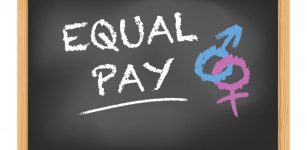The Slow Passage of Women’s Workplace Rights in Australia

Despite years of legislating against the gender pay gap, it remains a persistent feature of the Australian workplace. Unequal pay outcomes for women are a stark reminder that there’s an antiquated perception that a woman’s contribution in the workplace is somehow lesser than a man’s.
Released last month, the second annual Gender Equity Insights report outlines that the gap between women and men’s salaries has dropped slightly from 23.9 percent in 2015 to 23.1 in 2016. But the researchers attribute this to economic downturn, rather than any actual improvements.
While it’s hard to believe that in 2017 we’re still having conversations about women’s inequality in the workplace, situations have greatly improved.
Right up until 1969, Australian legislation allowed employers to pay women a minimum rate of pay that was 25 percent less than male employees doing the same or similar work.
So it’s important to remember that many women have been fighting for equality since early last century and they’ve succeeded in bettering women’s position at work. We decided to take a look at some of the laws that have led to empowering women in the work environment.
The early days
The Universal Declaration of Human Rights recognised the principle of equal pay for equal work in 1948. Since this recognition, women’s right to equal remuneration has been increasingly lobbied for around the world.
An early example of equal pay rights on the Australian scene was in NSW, when the Industrial Arbitration (Female Rates) Amendment Act was passed through state parliament in 1958. The legislation secured equal pay for women doing the same work as men, but didn’t apply to women whose work was “essentially or usually performed by women.”
The first federal equal pay case that granted equal pay for equal work to women nationally took place in 1969.The case and its resulting decision were prompted by the International Labour Organisation’s Convention on Equal Pay and the abolition of the basic wage.
However, like the earlier NSW legislation, this first equal pay case only established the equal pay right for women who were performing the same work as men. But it was an important first step that established equal pay for 18 percent of the female workforce, mainly for teachers and nurses.
The second federal equal pay case in 1972 resulted in the establishment of equal pay for work of equal value. Meaning that women were paid the same rate as men as long as their work, regardless of what profession, was assessed as of equal value.
This court’s ruling eventually put an end to separate award rates for women and men. And the gender pay gap dropped by 19 percent between 1972 and 1977.
The Sexual Discrimination Act
Australian senator Susan Ryan described Australia’s in the mid-70s as having one of the most gender-segregated labour markets of any developed nation. The senator went onto to introduce the 1984 Sexual Discrimination Act to federal parliament.
The bill attempted to establish equal access to employment, services and accommodation for women. It also made sexual harassment illegal for the first time in the country and established the Office of the Sex Discrimination Commissioner.
After a number of amendments were made to the act in 2013, today it protects people from discrimination based on sex, sexual orientation, gender identity, intersex status, marital or relationship status, pregnancy and breastfeeding.
And although discrimination and inequality do still occur in the Australian workplace, the effects of the Sexual Discrimination Act are viewed as being largely successful. And the law is seen as an important milestone in legislating for equal rights for women in this country.
Workplace relations
The Workplace Relations Act was passed by the Howard government in 1996. It provides for equal remuneration to be paid for women and men performing work of equal value. It established this principle in industrial awards.
The act also provided that all certified agreements and Australian Workplace Agreements were free from discrimination on the grounds of sex.
If the Sex Discrimination Commissioner finds any award or agreement is discriminatory in nature, they will refer it to the Australian Industrial Relations Commission for review.
Equal opportunities in the workplace
Another milestone piece of legislation that helped open doors for women at work was the Equal Opportunity for Women in the Workplace Act (EOWA) 1999. As the name implies, it required employers to promote equal opportunity for women in employment.
This entailed women being dealt with on the basis of merit when it came to employment. The elimination of workplace discrimination was another key aim of the legislation, along with fostering a consultation process with employers on issues concerning equal opportunities for women.
The EOWA also established the Equal Opportunity for Women in the Workplace Agency that had the role of administering the act. The agency would do so through educating and assisting organisations in their approach to achieving equal opportunities for women.
Workplace gender equality
The Workplace Gender Equality Act 2012 replaced the EOWA. This legislation aims to improve and promote equality in the workplace for women and men.
While this new legislation does include men as well as women, it does have a focus on equal remuneration for women, removing the barriers for equal participation of women in the workforce and promoting the elimination of discrimination based on gender, including in relation to family and caring responsibilities.
The Workplace Gender Equality Agency has replaced the Equal Opportunity for Women in the Workplace Agency and serves a similar function.
The battle is far from over
All this legislation has brought about improvements for women in the workplace. But as with the example of the gender pay gap, there’s still an urgent need to advance the rights of women at work.
A Senate inquiry has just been launched into gender segregation in the workforce. The inquiry will focus upon how this segregation impacts women economically and compare this nation’s circumstances with those of others.
The average yearly salary for a female-dominated industry is around $77,000, while for a majority male industry it’s about $92,000.
The Workplace Gender Equality Agency’s submission outlined occupational gender segregation as the second biggest contributor to the gender pay gap.
The agency recommends normalising flexible working hours for both women and men, a further focus on eradicating discrimination and creating opportunities for women to progress to leadership roles.
The committee is due to table their report on March 30.
Receive all of our articles weekly
Author

Paul Gregoire






